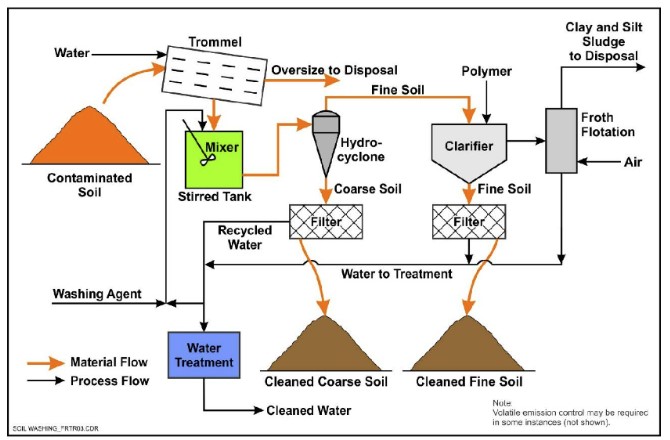The Complete Guide to Effective PFAS Treatment for Soil Contamination
Wiki Article
Innovative PFAS Therapy Solutions for Safer Water
The boosting frequency of PFAS contamination in water products necessitates an important exam of innovative treatment services. Furthermore, emerging bioremediation methods supply an even more sustainable method to dealing with PFAS difficulties. pfas management.Review of PFAS Contamination
PFAS contamination has actually become a significant environmental and public health issue. Per- and polyfluoroalkyl compounds (PFAS) are a group of artificial chemicals understood for their perseverance in the setting and body, leading them to be generally described as "for life chemicals." These substances have actually been commonly utilized in different markets, including firefighting foams, water-repellent textiles, and food product packaging, largely as a result of their water- and grease-resistant residential properties.The extensive use PFAS has resulted in their discovery in dirt, water materials, and even in the blood of humans and pets. Research studies have linked PFAS direct exposure to many health and wellness issues, including developing impacts in infants, immune system disorder, and various forms of cancer cells. Furthermore, the environmental persistence of these substances complicates their deterioration and removal, elevating worries about lasting environmental influences.
Governing bodies are significantly applying rigid standards to keep track of and minimize PFAS degrees in drinking water and other ecological tools. As recognition of PFAS contamination expands, it has become vital for neighborhoods and industries to seek effective therapy remedies to reduce direct exposure and guard public health and wellness.
Advanced Filtration Technologies
As the seriousness to address PFAS contamination escalates, advanced purification innovations have actually emerged as an essential part in the remediation initiatives targeted at eliminating these relentless chemicals from water sources. These modern technologies leverage advanced devices to effectively target and catch PFAS substances, which are notoriously resistant to traditional therapy methods.One of the most appealing methods is the usage of granular activated carbon (GAC), which adsorbs PFAS molecules as a result of its high area and porous structure. This technique has actually been extensively implemented in both municipal and industrial settings, demonstrating substantial decreases in PFAS focus. Additionally, ion exchange resins have acquired grip, particularly made to uniquely bind PFAS ions from water, thus facilitating their removal.
Membrane filtration innovations, such as reverse osmosis and nanofiltration, likewise reveal effectiveness in PFAS elimination by literally dividing pollutants from water - pfas management. These systems can accomplish high levels of pureness, making them ideal for drinking water applications
Chemical Treatment Advancements
Many chemical therapy advancements are being checked out to successfully attend to PFAS contamination in water materials. One promising method involves using innovative oxidation procedures (AOPs), which make use of effective oxidants such as ozone, hydrogen peroxide, or chlorine dioxide integrated with UV light to break down PFAS compounds right into much less dangerous substances. This method has actually shown effectiveness in laboratory settings, revealing prospective for scalability in real-world applications.One more innovative approach is the growth of ion-exchange materials particularly designed to target PFAS. These resins can uniquely adsorb PFAS compounds from water, permitting their elimination throughout treatment procedures. Current developments have boosted the effectiveness and capacity of these materials, making them a positive choice for water therapy centers.
In addition, researchers are checking out making use of chemical agents like persulfate and ferrous ions to boost the deterioration of PFAS in contaminated water. These representatives can cause chemical reactions that promote the malfunction of persistent PFAS substances.
Emerging Bioremediation Methods
Recent improvements in chemical treatment advancements have led the way for discovering bioremediation techniques as a sensible option for addressing PFAS contamination. Bioremediation takes advantage of the all-natural metabolic processes of microbes to degrade or change pollutants, making it pfas treatment an attractive approach for tackling relentless contaminants like PFAS.
Emerging strategies in bioremediation include making use of genetically crafted bacteria that can especially target and break down PFAS compounds. These microbial stress are being created for their enhanced deterioration capabilities, boosting the efficiency of the remediation procedure. In addition, scientists are examining the capacity of plant-assisted bioremediation, where particular plant varieties may uptake and sequester PFAS from polluted soil and water.
Another encouraging method is the application of bioaugmentation, which entails presenting helpful bacteria into contaminated settings to boost the degradation of PFAS. This technique can promote much faster remediation timelines and boost overall effectiveness.

Governing Structures and Standards
A comprehensive regulatory framework is important for efficiently handling PFAS contamination and making sure public health and wellness security. The boosting recognition of per- and polyfluoroalkyl compounds (PFAS) as toxic wastes has prompted various government and state firms to create requirements that regulate their existence in water supplies. The U.S. Environmental Protection Agency (EPA) has actually developed health advisories and is functioning towards setting enforceable limits for PFAS in alcohol consumption water.State-level laws differ substantially, with some states embracing stricter standards than those suggested by the EPA. These policies usually consist of maximum impurity degrees (MCLs) for particular PFAS substances, surveillance demands, and reporting obligations for water energies. Furthermore, emerging structures focus on the removal of polluted sites, stressing the requirement for effective therapy innovations.

Final Thought
In final thought, the development and execution of ingenious PFAS treatment solutions are essential for attending to the pervasive issue of water contamination. Advanced purification modern technologies, chemical treatments, and arising bioremediation methods collectively offer a diverse approach to properly decrease and degrade PFAS degrees. As regulatory structures continue to evolve, incorporating these innovations will certainly be necessary to safeguard public wellness and restore the honesty of contaminated water resources, ultimately adding to a cleaner and safer atmosphere.Report this wiki page